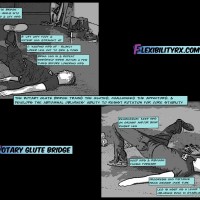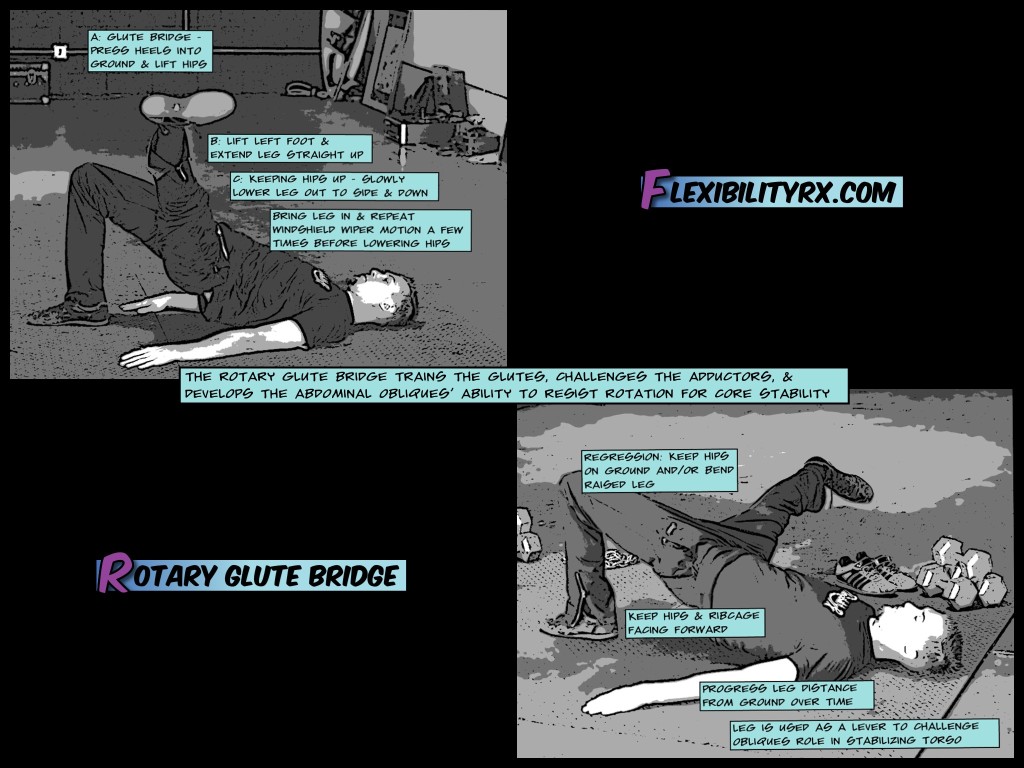
Improving Rotary Stability with the Rotary Glute Bridge
The glute bridge is a fundamental movement for training hip extension. The glute bridge with posterior pelvic tilt (pelvic lift) is often used in physical therapy and chiropractic clinics to treat low back pain.
The glute bridge is a great pre-workout exercise that teaches the glute max to function as the primary hip extensor. Athletes with low back pain often recruit the low back and hamstrings instead of the glutes during deadlifts. The glute bridge also stretches the hip flexors.
The Rotary Glute Bridge
The rotary glute bridge is an exercise that Eric Cressey posted in the video shown below (I have renamed the exercise). The exercise builds on the traditional glute bridge using the outstretched leg to challenge the abdominal obliques to prevent rotation of the low back.
Anti-movements like the front plank and side plank train the core to resist movement. The front plank trains anterior core stability, the side plank trains lateral stability, and the rotary glute bridge trains rotary stability.
Avoiding Lumbar Rotation
One of the biggest sources of low back pain is excessive rotation of the lumbar spine. Runners need to prevent rotation during forward movement and golfers need to rotate through the thoracic spine while stabilizing the low back (preventing rotation).
When the hips or thoracic spine lose mobility – excessive movement occurs at the low back. While the thoracic spine and hips are built for mobility, the low back needs stability.
It is important to both train rotary stability at the low back and avoid excessive lumbar rotation during low back stretches.
Strength coach Mike Boyle notes, “The biggest mistake we have made in training over the last 10 years is an active attempt to increase the static and active range of motion of an area that requires stability. Most, if not all, of the many rotary exercises done for the lumbar spine were misdirected.”
Physical therapist Shirley Sahrmann in Diagnosis and Treatment of Movement Impairment Syndromes, explains that, “Attempting to increase lumbar spine range of motion is not recommended and is potentially dangerous. Our lack of understanding of thoracic mobility caused us to try to gain lumbar rotary ROM, and this was a huge mistake.”
– Kevin Kula, “The Flexibility Coach” – Creator of FlexibilityRx™ – www.FlexibilityRx.com
Related Resources
Dynamic Chiropractic: Stop Stretching – or at Least Stop Stretching the Lower Back Into Flexion and Rotation (link)
Eric Cressey: Supine Leg Whip for Hip Mobility and Core Stability (link)
Tags: Functional Movement Screen, Rotary Band Plank, Rotary Glute Bridge, rotary stability

Leave A Reply (No comments so far)
You must be logged in to post a comment.
No comments yet